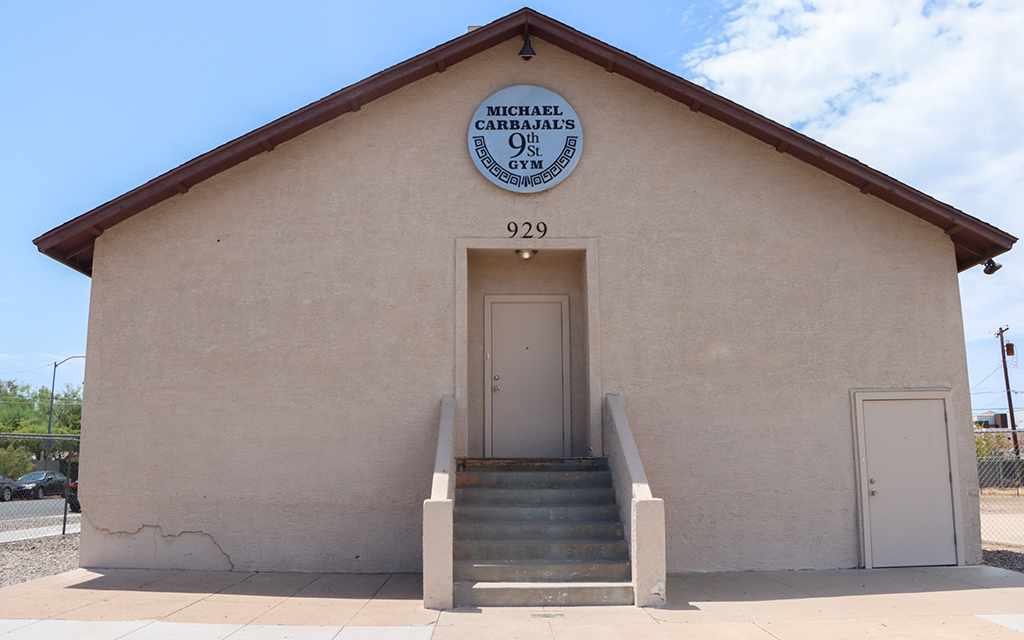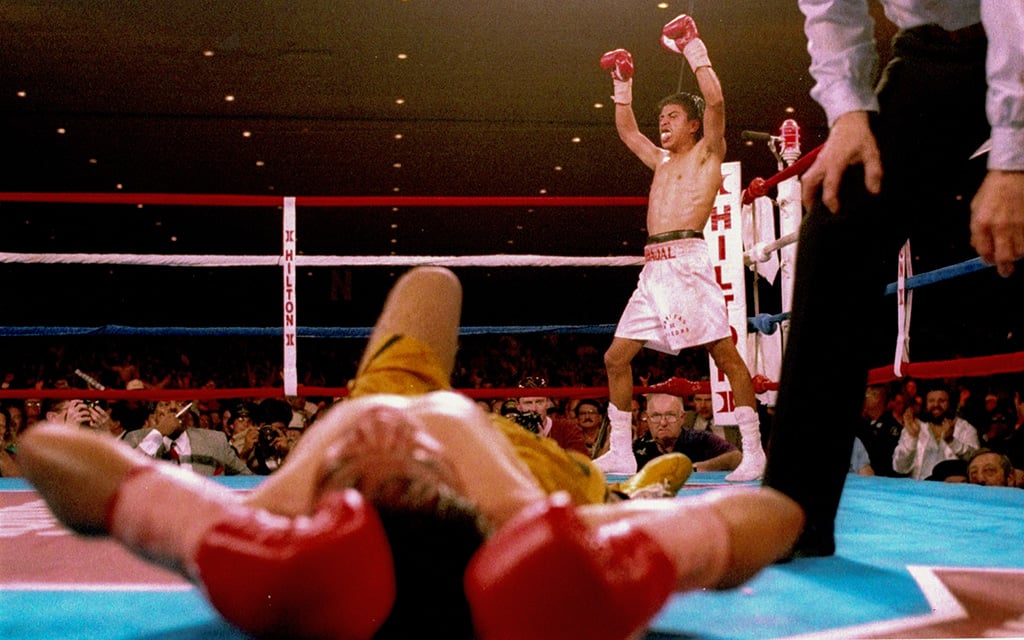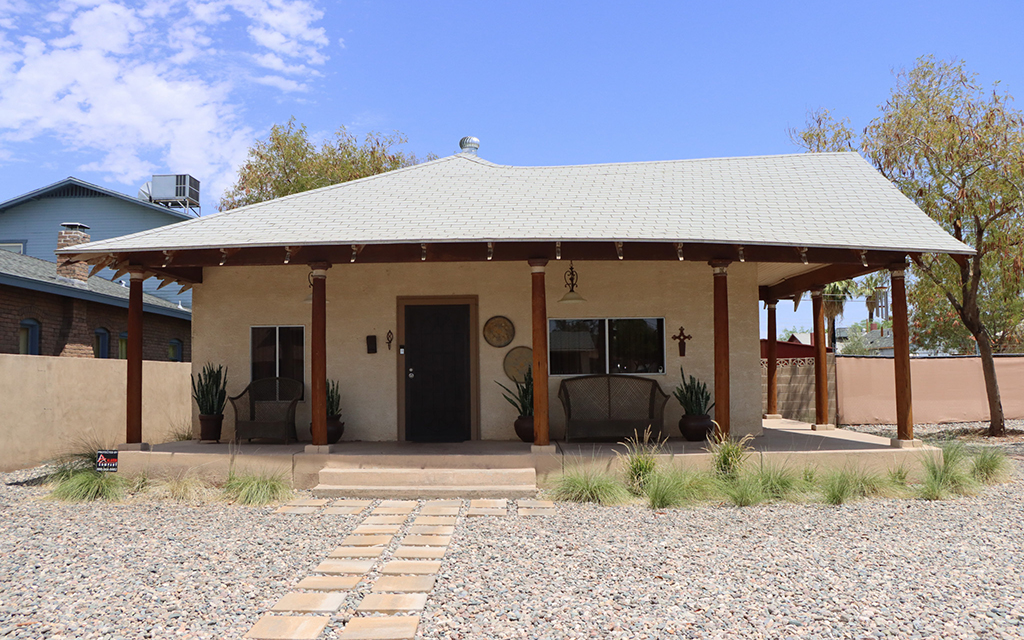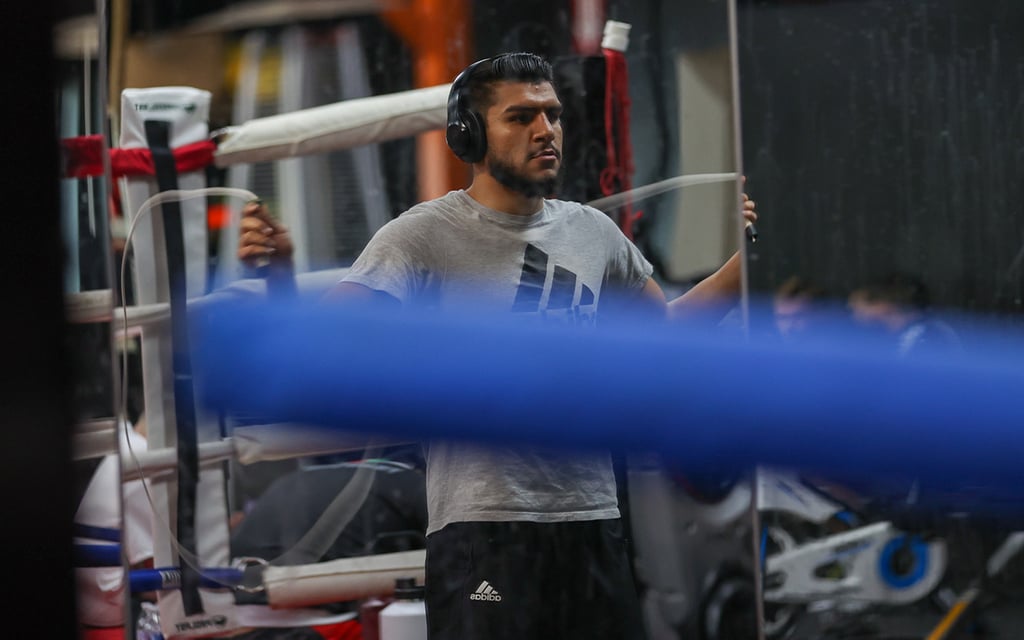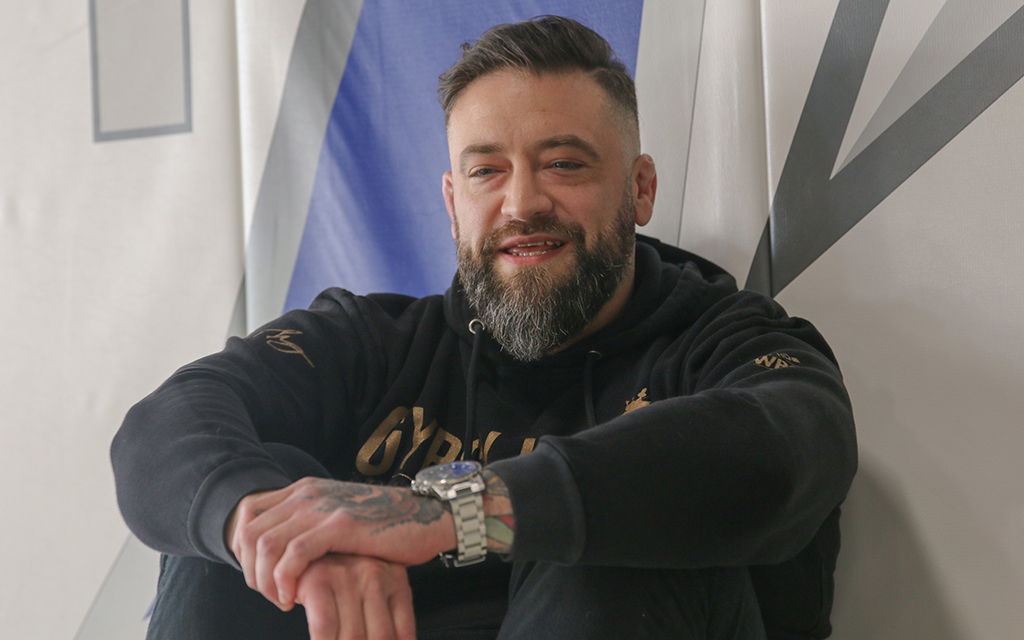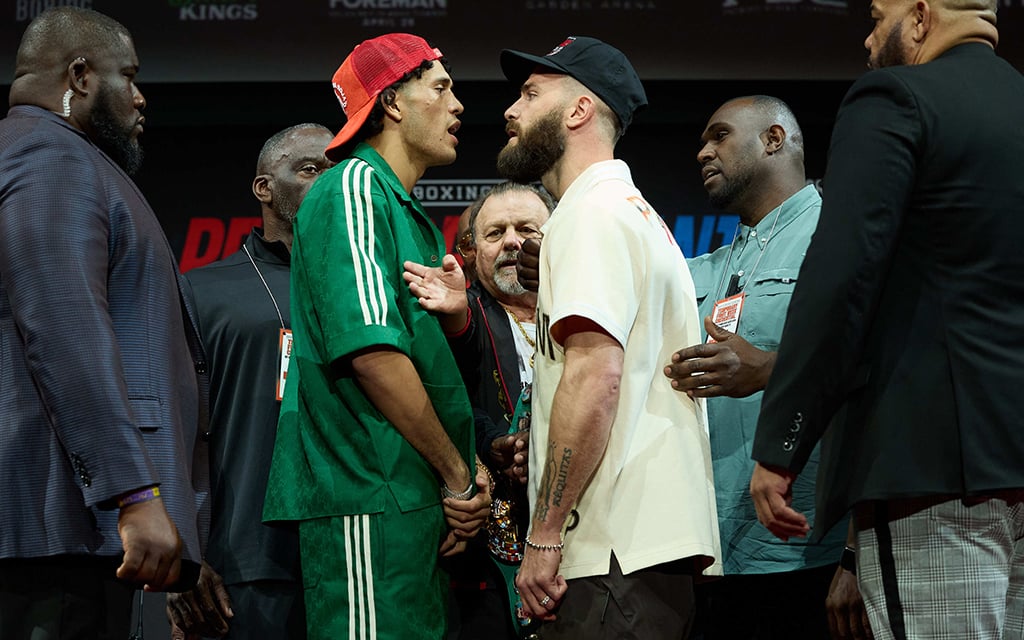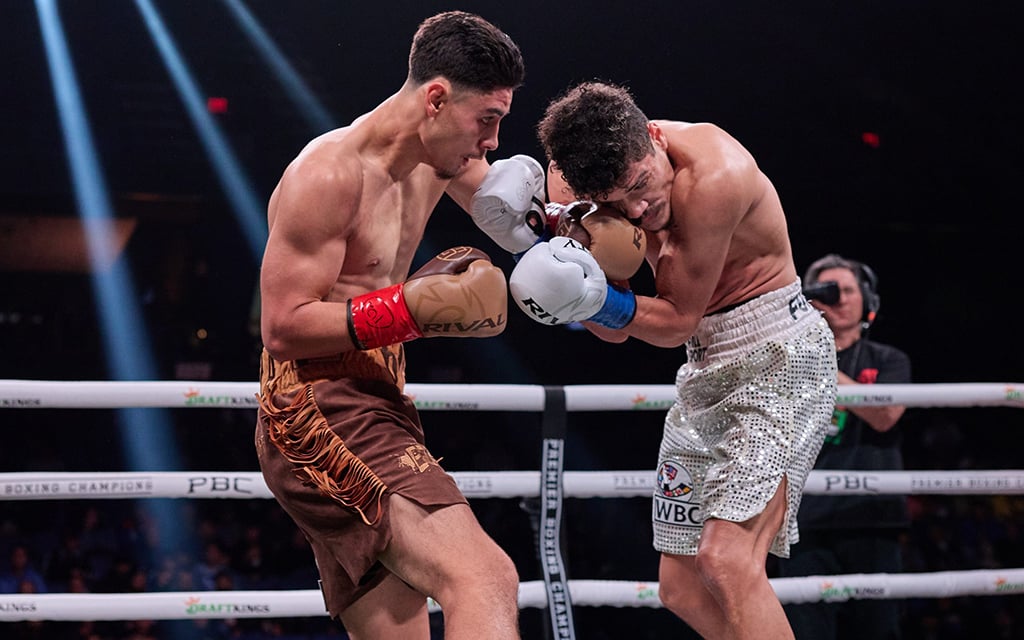PHOENIX – Michael Carbajal – like a select few of each generation’s finest boxers – was born to fight. While he may not remember it, a 6-year-old Carbajal told his father he was going to win a world championship and retire as a champion, both of which he accomplished in his illustrious career.
Along the way he became a unified champion, defended his titles 11 times and was crowned Ring Magazine’s 1993 Fighter of the Year, before ultimately securing his spot in the International Boxing Hall of Fame as the second fighter from Arizona to do so.
“I started (boxing) and then finally in my first fight, (my dad) came up to me, he goes, ‘You remember what you told me when you were 6 years old?’” Carbajal told Cronkite News. “I said ‘No.’ And he said, ‘You told me that you’re going to be a world champion and you told me you’re going to retire world champion.’ I said, ‘I said that?’”
Today, Carbajal is doing his part to contribute to the next generation of Phoenix boxers through Michael Carbajal’s 9th Street Gym, located a few hundred yards from his childhood home. Carbajal is there almost every day helping to guide boxers of all ages, whether they are looking to get involved in the amateur scene or just stay in shape.
“Anyone can come in here, like I said they don’t have to fight. Anyone,” Carbajal said. “We get everybody coming in. We got 82-year-olds that have been in here. It’s crazy and I love it because, you know, that helps them.”
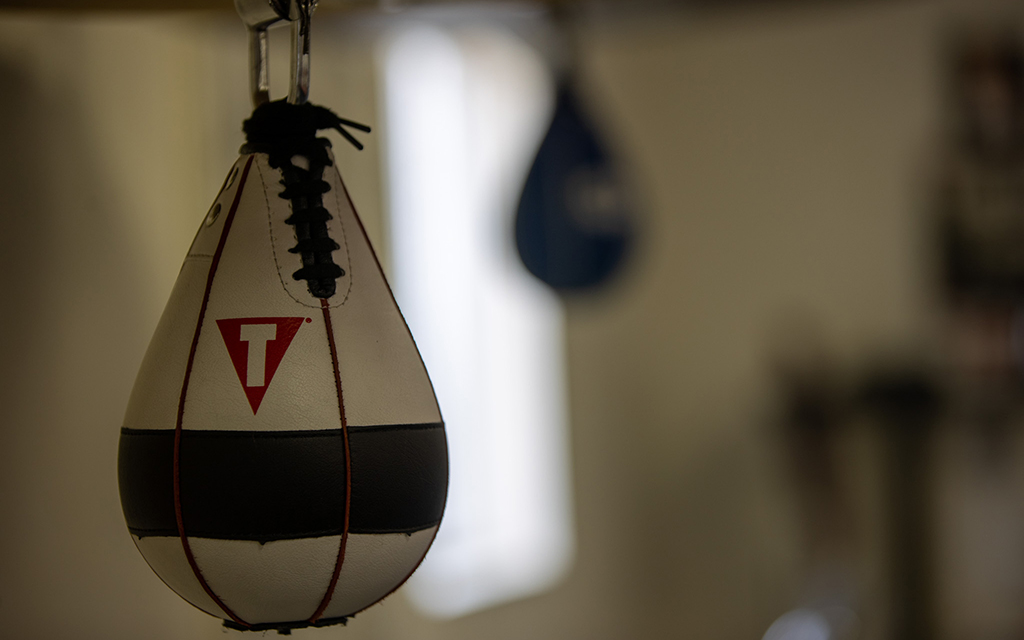
Amidst the rough streets of Phoenix, Michael Carbajal’s gym stands as a beacon of hope, inspiring the local youth to chase their dreams. His journey from a determined 6-year-old to a world champion continues to inspire generations to come. (File photo by Damian Rios/Cronkite News)
Each afternoon the gym fills up with people of all ages looking to learn from the best, whether it’s their first time hitting a bag or they’re gearing up for a fight. Inside the gym, the back wall serves as a tribute to Carbajal’s career with images from his Olympic days, his trilogy with Humberto “Chiquita” Gonzalez and even photos with stars such as Charles Barkley and Sylvester Stallone scattered across the wall.
During his career, Carbajal continued training where he began his boxing journey, in his backyard gym, while leaving the gym down the street open for young kids in the area to train. That gym was more modest than the one he now trains others in on 9th Street and Fillmore. He had the backyard of his childhood home set up with a ring and rigged with all the equipment necessary for him to develop into a world champion.
Paul Rubin, who first covered Carbajal for the Phoenix New Times before his Olympics appearance and is currently writing a book on Carbajal and his family, vividly remembers the makeshift training grounds.
“It was incredible. It was unbelievable. It was a little tin shed … low roof, low ceiling. And the ring was small, there was no room to move … It was really hot sometimes in the summer,” Rubin said. “And then outside they had rig-ups on trees …. tires and (they) did all this stuff to this whole area and it was amazing.”
As a neighborhood kid, it only made sense that Carbajal would continue on training in his backyard, under the tutelage of his family members. Carbajal credits his entrance into boxing to his father, Manuel, who was a state Golden Gloves champion himself. He was trained by his now-estranged older brother, Danny.
Danny trained Carbajal during his whole career, but after his retirement, served 3 1/2 years in prison for stealing hundreds of thousands of dollars in retirement accounts and properties from his then-wife, Sally. Carbajal reportedly lost millions of dollars as well, though Danny was never convicted despite allegations he was behind the theft after doubling as his brother’s financial manager throughout his career.
Despite the current rift between them, Carbajal’s brother trained him and initially built the backyard gym that spurred his Hall of Fame career.
After success in the amateurs, Carbajal burst onto the scene during the 1988 Olympics in Seoul, South Korea, where he represented the United States alongside fellow Hall of Famers Roy Jones Jr. and Riddick Bowe. Carbajal was well-spoken and humble; those traits coupled with his relentless aggression inside the ring garnered him attention in the States previously unseen by fighters of his size.
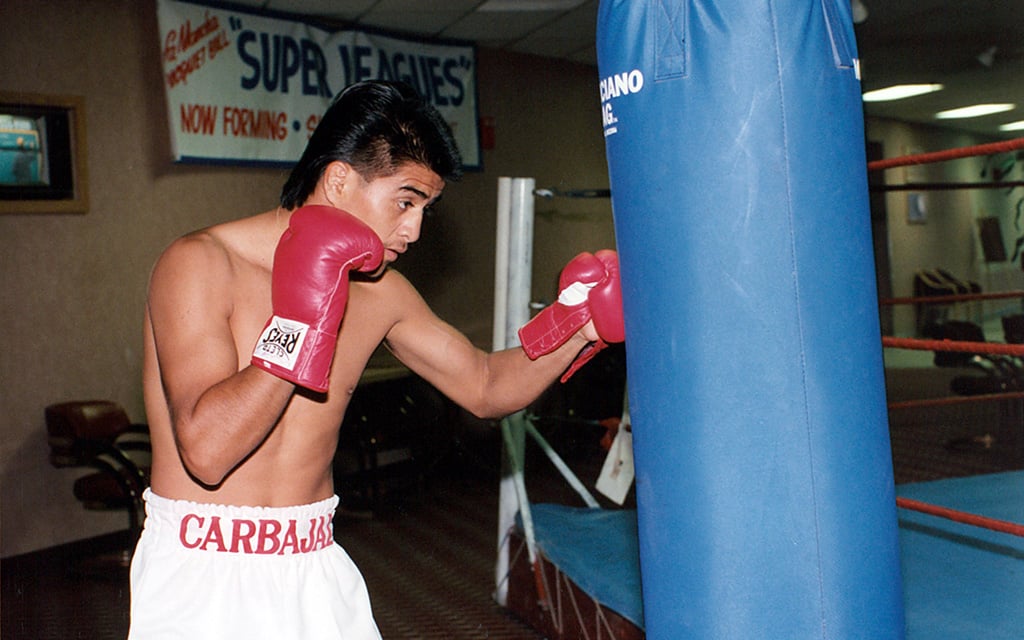
Michael Carbajal’s Hall of Fame induction immortalizes his remarkable impact on the sport, paving the way for future generations of boxers in Arizona and beyond. (Photo courtesy of Stephen Dunn/Allsport)
Pioneering spotlight for smallest boxing weight divisions in America
Standing at 5-feet-5, Carbajal spent the majority of his career fighting at junior flyweight, which limits fighters to a maximum weight of 108 pounds. Historically, fighters in the smallest weight classes have had lesser name recognition and, especially in the U.S., drew nowhere near the same attention as their welterweight, middleweight or heavyweight counterparts.
Carbajal began to turn the tide in 1988 as he battled his way through four fighters in the Olympics before being defeated controversially in the gold medal fight. Along the way he developed a following, nowhere larger than in his hometown of Phoenix, that would continue into his professional career.
Norm Frauenheim, a former longtime reporter with the Arizona Republic and a recipient of the Fleischer Award for excellence in boxing journalism, began covering Carbajal during the ‘88 Olympics before returning to Phoenix to cover Carbajal throughout the remainder of his career.
“He was in a weight class, 108 pounds, that nobody paid attention to at the time, but he projected well on television,” Frauenheim said. “At that time, NBC … they still showed boxing as a major sport. They don’t anymore, but people got interested in him. He looked bigger on the screen, he projected a certain charisma on the screen.”
Prior to Carbajal, the majority of fighters in his weight class came from overseas and struggled to appeal to audiences in the U.S., which led to a lack of television coverage, only exacerbating the issue. Then Carbajal came around, an English-speaking fighter who’d risen from the tough streets of Phoenix to compete on the biggest stage of amateur boxing, a storyline that hooked many.
“He seemed very humble and mature for his age and he was a little more mature than some of the others, he was older,” Doug Fischer, current Editor-In-Chief of The Ring, said. “A lot of those guys were in their teens … but also, he just had a level of humility that was refreshing.”
Upon his return to Phoenix from his silver-medal winning campaign, Carbajal was greeted by an endless sea of bodies lined from the airport all the way to his home on Ninth St. and Fillmore, all gathered in ecstatic celebration of his Olympic performance.
“It was crazy. I couldn’t believe it. I said ‘Damn, I just fought in there. That’s all I did.’ But after a while, you know, when I look back and start thinking about it I said, ‘Damn, I remember all that now.’ And I know why all the people came, because everybody’s looking at the Olympics and I came right out of the neighborhood,” Carbajal said. “That’s why they love that story. They love that story, (because) I just came out of the neighborhood.”
In the aftermath of the Olympics, Carbajal signed his first professional contract with Bob Arum and Top Rank, which had recently moved its offices from New York to Las Vegas to help establish a presence on the West Coast.
“He was the only (small fighter signed to Top Rank),” Bruce Trampler, Hall of Fame matchmaker with Top Rank, said. “To be fair, there were no small stars in boxing. By small, you know, lighter-weight stars. Most of the little guys fought in California, the Mexicans, Mexican Americans, which Michael is. But, we were based in New York at that time. We couldn’t relate to it. We didn’t care.
“When I got out (to Vegas) in mid ‘87, my mandate was to spread it out. We got our guys on the East Coast, let’s open up the western part of the country. So we did shows in Albuquerque, Phoenix, Reno, you know, things we weren’t previously doing as a company.”
Carbajal represented something new for Top Rank on multiple fronts. The promotional company had yet to dip its feet into the smallest weight classes, and Carbajal gave them a chance to tap into a new market. Not only did he help bring eyes to the junior flyweight division, he also helped to establish Phoenix as a successful boxing market, the aftereffects of which can still be seen today.
“Nobody realized that this market was there,” Frauenheim said. “And because of the crowd(s) that just showed up, Arum realized. You know, Michael helped him discover a new market, which was important because it wasn’t long after that (Mike) Tyson was going to jail. So there was this Latino market and I do think it also helped Bob get ready for Oscar De La Hoya.”
The Phoenix fight fans came out in masses to support the local kid who had made it onto the big stage, packing Veterans Memorial Coliseum and, later, America West Arena, which is now called Footprint Center. While Winkelman native Louie Espinoza had already won a world boxing title in 1987, Carbajal represented something different being born and raised in the heart of Phoenix.
“Around that time, he certainly was the face of boxing in Phoenix,” Al Bernstein, Hall of Fame boxing commentator, said. “And even now we’ve had fighters from the Phoenix area, David Benavidez and a few other fighters, and you know at one point I think Mauro (Ranallo) even said somewhere Michael Carbajal is smiling, but yeah, no question he was the face of Phoenix boxing.
“He filled (America West Arena) up with people, which was not that easy to do … He brought fans out in the Phoenix area and it was twofold; one, of course, they were rooting for him to succeed and (two) he created excitement in his matches so it was a perfect marriage.”
Carbajal’s style drew him plenty of supporters; with devastating punching power, calculated aggression and plenty of finesse, he often found himself in back-and-forth brawls but rarely looked uncomfortable.
“Carbajal is a technician. He is a quintessential boxer puncher. That means he’s looking to land hard punches but always with good, proper balance and textbook technique,” Fischer said. “Everything he does is right out of the textbook. His fundamentals are all on point and then backing that up is warrior spirit and toughness, durability.”
Early in his career, Carbajal had fantastic conditioning, but he did not always need it as his strong chin allowed him to take damage from his opponents as he traded at close range. Throughout his career he took plenty of hard shots, yet more often than not Carbajal would respond to being knocked down with an even harder punch of his own.
“He could box when he wanted to. I mean, he came up in the Olympic stuff, so he had all of that and he moved his feet well,” Frauenheim said. “He didn’t exactly cut off the ring as well as some guys, but he was in there to kick your a–. He wanted to punish you … he had that instinct.”
Unforgettable Showdown: Carbajal vs. Chiquita I
That instinct showed itself in Ring Magazine’s 1993 Fight of the Year as Carbajal took on his toughest opponent to date, “Chiquita” Gonzalez, in a junior flyweight title unification bout. Carbajal entered the fight with six defenses of the IBF title under his belt while Gonzalez was coming off of four straight title defenses in his second reign as WBC champion.
“Yeah, it was looming, because we were both big,” Carbajal said. “He was big in Los Angeles, he was at The Forum and he was knocking everybody out … they asked me about him and I would say, ‘Well I haven’t seen him fight yet.’ So when I first saw him fight, I said, ‘Oh hell yeah, I want to fight him.’”
The fight represented a monumental landmark for fighters of that weight class as it was the first time a junior flyweight bout had ever headlined a pay-per-view card. Although from Mexico, Gonzalez’s adopted hometown was Los Angeles where he’d become a popular draw at The Forum. Similarly Carbajal was a draw in Phoenix, so Top Rank and the fighters agreed to hold the bout at the Las Vegas Hilton, a neutral location.
“You had a Mexican national (Gonzalez) who brought the California market and his whole country,” Trampler said. “And you had an American who received U.S. network TV coverage, exposure. And both, in addition to their appeal to fans and viewers, both were undefeated, tremendous fighters. And so it was just natural in terms of them eventually coming together.”
Inside a packed arena in Las Vegas, Carbajal and Gonzalez put on a show that proved to everyone in boxing that junior flyweights were worth the investment from promoters.
“That would be in the top seven or eight of all the fights I’ve ever announced. It was a remarkable fight,” said Bernstein, whose exclusive list likely includes arguably the greatest fight of all-time, Marvelous Marvin Hagler versus Thomas “The Hitman” Hearns.
In the fight, Carbajal came from behind in thrilling fashion after getting knocked to the canvas twice before delivering a thumping knockdown of his own in the seventh round that Gonzalez would not get up from.
After securing the victory and joining the WBC belt with his IBF title, Carbajal dropped to the ground in celebration as his team burst into the ring around him lifting him up and parading him around the ring as he raised his arms high in the sky.
Fischer remembers watching the fight on television and seeing the Top Rank staff run into the ring celebrating, equally as ecstatic as Carbajal and his team.
“They jump in the ring and they’re as excited as Carbajal’s corner,” Fischer said. “Like they’re so happy for him because he is such a nice guy, you know what I mean, and easy to work with. I mean he was their guy, I get it, but you’re never going to see them that excited about a win.”
The win was the biggest of Carbajal’s career to date and after two defenses of his titles to close out the year, he secured The Ring’s prestigious Fighter of the Year award for 1993. He also closed out the year ranked as the fourth best fighter pound-for-pound by The Ring, a feat seldom achieved by fighters of Carbajal’s size.
“Think about this, he was on the cover of Ring Magazine as Fighter of the Year. How long would it be before the magazine would feature on the cover a junior flyweight or a flyweight? You know what I mean,” Fischer said. “They don’t sell in the U.S. … It’s so freaking rare.”
The fight was a major success not only financially but also in terms of increasing the number of eyes on the smallest fighters. They proved the junior flyweight division had the potential to be very profitable and that smaller fighters were among the most talented in the world.
“It did very well and the fight lived up to the hype. It was one of those fights where there was no loser,” Trampler said. “It was such a tremendous action fight. Today there’s a lot of focus on the guy’s quote unquote legacy or his undefeated record. Guys back then just fought and if you lost, you lost.”
Carbajal and Gonzalez’s willingness to take risks in the ring and face the best paid off in a big way in 1993 as each fighter secured their biggest payday to date. The success of the pay-per-view also helped to secure Carbajal and Gonzalez even larger paydays in the subsequent rematches.
“(Top Rank) didn’t just do (a PPV) out of the kindness of their heart. It made sense,” Fischer said. “They knew they were going to get the crowd, right? They knew they were going to get, you know, obviously a good fight that would probably spin into a rematch. So they’re kind of covered in that way … you know, it made sense, they could do that. So he’s really kind of a pioneer in that regard and that year that fight was Ring Magazine Fight of the Year.”
In hindsight, it was a monumental fight and moment for the junior flyweight division, but at the time Carbajal was purely focused on the action in the ring, with the strides made for lighter-weight fighters taking a backseat in his mind.
“I never really paid no mind to it at the time … But you’re bringing the smaller weight classes up, you know, everybody’s starting to notice,” Carbajal said. “At the time I wasn’t even thinking about it. They had me on ABC, NBC, CBS on all the national TV (channels) … but at the time I didn’t even worry about it. I just (thought), look, I’m fighting, I love the sport, if I keep fighting the way that I do and get that world title, I’m good.”
While the evolution of the junior flyweight division was not on Carbajal’s mind during his career, since retiring he’s been able to look back and acknowledge the role he played in building a platform for fighters in the smallest weight classes.
“I’ll tell you why I take some credit, because they always say, ‘Is there going to be another Michael Carbajal?’ They were doing that with ‘Chocolatito,’” Carbajal said. “‘Is there going to be another Michael Carbajal?’ And I looked at ‘Chocolatito’ and I said at least that boy can fight. I can go, ‘Okay, let them, if he can be another Michael Carbajal, let it be.’ And that’s the way I take it.”
Retirement to redemption: Carbajal’s storybook comeback
After two defenses of his unified titles, Carbajal signed on to get back in the ring with Gonzalez for a rematch, where he would suffer the first defeat of his career as Gonzalez evened their series just 11 months after the first bout.
For the rematches, Gonzalez brought Hall of Fame trainer Ignacio “Nacho” Beristáin on to his team. He opted against a slugfest as the first fight had been and had Gonzalez box Carbajal, sticking and moving around the ring, which ultimately secured him two wins in the final two fights.
Carbajal would bounce back to win the IBF flyweight title again in 1996, defending it twice before being upset in a title defense against an undefeated Mauricio Pastrana the next year. After suffering a second loss in 1997 to Jacob Matlala, Carbajal retired from the sport altogether.
However, he had yet to achieve one of his childhood goals of retiring as a world champion and after two years out of the ring, a sparring session reignited the flame within Carbajal and he decided to make one last run at a title.
Carbajal made his return to boxing in 1999, winning three fights that year, two of them early stoppages, before he got a chance to fight an up-and-coming Jorge Arce for the WBO junior flyweight title. Arce would go on to become a four-division world champion but at the time he was defending his first belt for just the second time.
“Michael Carbajal was brought in … to provide this big name. They thought, well this is the passing of the torch from a legend to Jorge Arce and he would then move forward,” Bernstein, who commentated the fight, said. “And the way the fight was going, it certainly looked like that was going to happen and then Michael Carbajal came up with lightning in a bottle.”
Heading into the penultimate round of the fight, Carbajal was down substantially on all three of the judge’s scorecards, having lost every round but one, and no doubt needed a knockout to win.
Comfortably on his way to victory, outlanding Carbajal, Arce suddenly was caught with his guard down and Carbajal landed a thumping right hand that visibly shook up Arce. Carbajal pounced on Arce, who slipped and then stumbled across the ring prompting the referee to end the fight, securing a shocking come-from-behind victory for Carbajal.
Carbajal had won the WBO junior flyweight against all odds and ultimately earned Ring Magazine’s Comeback Fighter of the Year in 1999.
He then decided it was time to hang up the gloves once and for all, ending his career on top as world champion, as he’d told his father he would.
“When you think of a fighter ending their career on an upbeat note, I mean, that’s one of the more extraordinary endings to a boxing career I think that anybody’s ever had … It was remarkable,” Bernstein said. “It didn’t look like he was going to be able to do that in that fight and then (he) demonstrated this kind of microcosm of his career, the idea of beating the odds and overcoming a lot to, you know, to win.”
Since retirement, Carbajal has been honored with the most prestigious award in boxing, a spot in the International Boxing Hall of Fame in Canastota, New York. He was inducted in 2006 alongside his three-time dancing partner, Gonzalez, becoming the second fighter from Arizona to be inducted after Chalky Wright. In 2019, he became the first ever boxer to be inducted into the Arizona Sports Hall of Fame.
“He’s the kid from the mean streets of Phoenix who – he didn’t get out of the mean streets because he stayed there – but he’s the guy who made it to the top, you know, blah, blah, blah. And I mean, he was just a guy and that’s the thing,” Rubin said. “I mean, he’s just a guy who worked his a– off and became a world champion and made a lot of money doing it, which was totally improbable. And it hasn’t happened since.”
Carbajal’s enduring presence in boxing still felt in Valley
Carbajal left a footprint on boxing in the Valley that can still be seen to this day. He helped open the doors to Phoenix as a market where local fighters like former two-time champion Benavidez have established themselves in recent years, selling solid gates at venues across Phoenix.
In late 2021, Benavidez headlined his first big card in the Valley at the Footprint Center, a venue Carbajal headlined three cards in, defeating Kyrone Davis with a seventh-round knockout. He returned to Phoenix for his next fight headlining a card at Desert Diamond Arena in Glendale, where he picked up an interim title.
At 26-years old, Benavidez looks to be Phoenix’s brightest hope to bring a world title back to the city and with a handful of hometown fights under his belt already, it would be no surprise to see him return to the Valley again soon.
Late last year, the Valley hosted a title matchup between two of the greatest little fighters of all-time, Juan Francisico Estrada and Roman “Chocolatito” Gonzalez, as they battled for a third and likely final time in front of just over 9,000 fans at Desert Diamond Arena.
“I was proud of Phoenix that night because I thought the crowd was educated, it knew who these guys were and it also knew what it was watching and you won’t find that in every boxing market,” Frauenheim said. “But I think one of the reasons that was true was because this was Michael Carbajal’s home. So a lot of those people had grown up with their fathers as Michael Carbajal fans … the base of the market that’s now turning Phoenix into a big market, ironically, I think their daddies were fans of Michael Carbajal.”
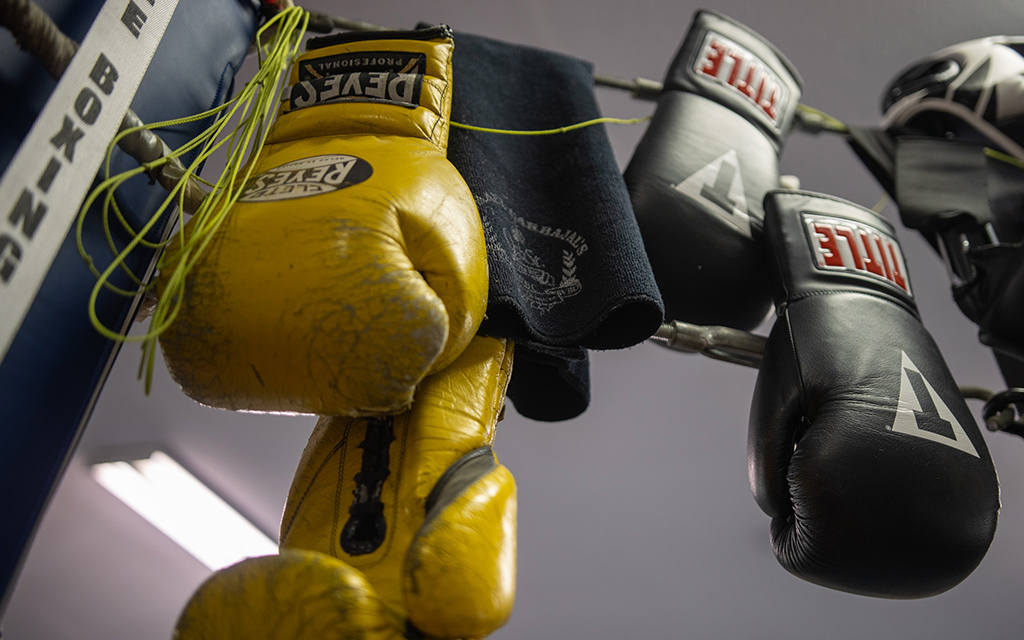
Step into Michael Carbajal’s 9th Street Gym, a former church-turned-training ground for the next generation of Phoenix boxers. From amateurs to those seeking fitness, everyone is welcome here to hone their skills and find a sense of community. (File photo by Damian Rios/Cronkite News)
Carbajal does his part to continue supporting boxing in Phoenix, whether it be advice to young fighters or showing up to every big show hosted in the Valley. He was in attendance in February as Glendale hosted a junior lightweight title fight between Emanuel Navarrete and Liam Wilson. Carbajal’s appearance on the giant video board prompted cheers from around the arena as local boxing fans paid their respect to the city’s finest fighting product.
“Well like I always said, Louie started it. I wanted to be just like Louie, I said I’m going to win the title just like that. Now, I want all these kids from Arizona to say I want to win the title just like Michael and Louie did, or Louie and Michael did,” Carbajal said. “And I’m always up for the guys from Arizona. I’m always supporting them. Always. That’s it.
“I hope people break my records and I hope one of these guys from wherever in Arizona – I don’t care if you’re from Phoenix or Casa Grande or from Tucson or wherever you’re from – if you’re from Arizona, I’m with you. That’s it. And I hope someone comes up one day and does everything even better than I did. That’s how I am.”
Carbajal is hoping to develop the next Hall of Fame boxer from Arizona at his gym, where he has imparted the lessons he learned throughout his career, inside and outside the ring, to the next generation.
“I want to hear (them) say, ‘I want to be a champion. I want to be a world champion.’ That’s what I want to hear,” Carbajal said. “And if they don’t do that, then I show them. I tell them, ‘When you knock somebody out, that’s the best feeling in the world and you won’t understand it until it happens.’”
Originally a church, the building was renovated and turned into a gym in 1993, the year Carbajal won Fighter of the Year. The Ninth St. and Fillmore neighborhood has seen drastic changes since Carbajal’s fighting days, but the local gym was opened in an effort to provide a safe space for kids to come and train, a sentiment that remains today.
“It helps you out a lot to be in shape and conditioned and it relaxes you. You know, it relaxed me … and I tell the kids, ‘You guys don’t have to fight if you don’t want to,’” Carbajal said. “And some of them will come in and once I say that, ‘Oh yeah, I don’t want to fight. I just want to come and train,’ I say, ‘You can do that.’”
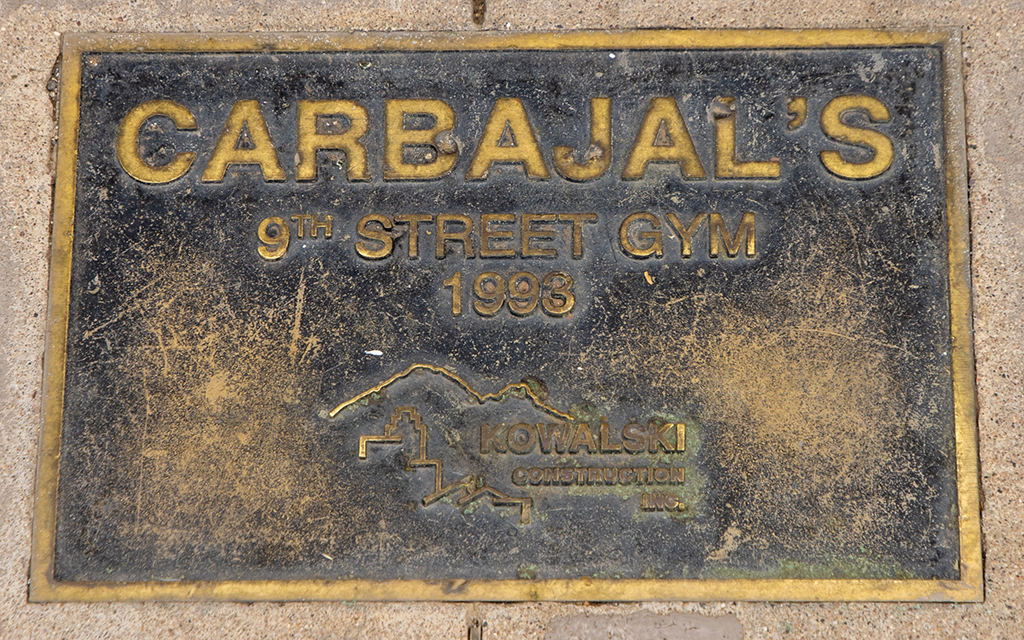
Michael Carbajal now imparts his wisdom and expertise to young fighters at his childhood neighborhood gym. The walls adorned with memorabilia tell the story of a career that changed the landscape of junior flyweight boxing forever. (File photo by Damian Rios/Cronkite News)
It’s the type of space many in his neighborhood needed, especially back when he was fighting. Historically, Carbajal’s neighborhood has been one of the rougher neighborhoods in Phoenix and throughout his career he faced pressure to leave and escape the trouble that permeated the streets, yet he never did.
“He was going off to tournaments, you know, he was in Colorado Springs in training,” Frauenheim said. “So his really hard involvement wasn’t there, but then when he got back and he became a world champion, he wouldn’t move and you know, that was admirable. But that was dangerous.”
Despite the issues that often surrounded those close to Carbajal, from an early age he only ever had one focus, becoming world champion, and that focus helped him to avoid and ultimately overcome much of the trouble that found many of his peers.
“I just, you know, just stayed focused. It was pretty easy to me. I just wanted to fight, become world champion, do what I do and I loved it. I was so in love with it, I didn’t care about all the other stuff. I know what I want,” Carbajal said. “And that’s what you have to do with a career. You got to love it, you got to love it dearly. Just as you love your wife, as you love your partner, you know, that’s the way it is. And you’ll make it.”
Carbajal’s story inside the ring remains to this day a legendary tale, one that has earned him a spot in the Hall of Fame, among the best boxers to ever step into the ring. His impact on the sport can still be seen to this day both locally and internationally.
His career helped to open the public’s eye, especially in America, to the junior flyweight division which had previously been lacking attention prior to Carbajal’s injection of poise and punching power. Carbajal’s presence and support in his hometown of Phoenix also opened the eyes of promoters to a new market that is now seeing a re-emergence through the likes of the Benavidez brothers and the Ramos family, thanks to the groundwork laid by Carbajal.
Despite the many doors that Carabjal opened for other fighters throughout his career and the countless honors he received in the process, he still feels like every other guy from the neighborhood.
“I think that everybody feels, you know, when they come around me they just think I’m normal.” Carbajal said. “They know I’m world champion and this and that and whatever, legendary and all that but, I’m just like you, just like her.”

